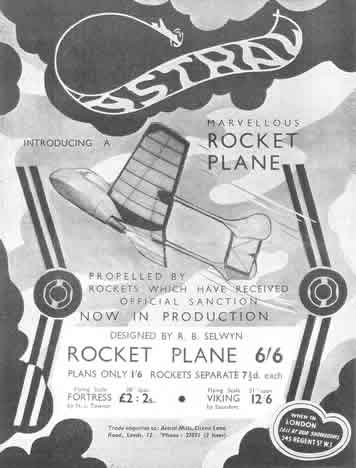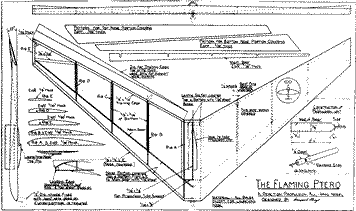|
The Astral
Rocket Plane
This advertisement for the "marvellous Rocket Plane" "now in production" by Astral Mills appeared in the November 1946 issue of Aeromodeller. Eighteen months later, the same magazine carried the announcement of the first Jetex motors, and the Astral Rocket Plane went OOS.
You can view a 4x enlargement of this advertisement at the bottom of the page.
Below is a reduced scale reproduction of the plan of the
Astral Rocket Plane. An enlarged version of the plan will be available from jetex.org at a later date.
Comment by the editor of SAM Speaks (Aug. 1997):
Doug McHard points out that the name of the designer (Royston B. Selwyn) of the Astral rocket model (only available for a few weeks in 1947) was an anagram of 'TOWNER' and 'BOYS'. He thinks they may have been hiding from the law – that on the use of fireworks! The "Flaming Ptero" is very like his own 1937 indoor model, plans of which appeared in the SMAE Journal shortly before it became "Model Aircraft". Mike Beach wrote about "F.T." in "SAM 35 Speaks", back in those early days when issues weren't numbered or dated! Howard himself wrote an article on rockets in the July 1947 issue of "A.M." and in the very next month appeared plans of A.J. Cockle's beautifully made but heavy D.H. Vampire.

|
 |
 |

|
In the August 1999 issue of 'SAM Speaks' (pp. 41-43), Doug McHard wrote about his youthful experiments with home-made rockets and rocket planes:
SHEFFIELD'S
SECRET WEAPONS FACTORY
In the June issue of 'Speaks', you question whether any reader of Model Engineer was foolish enough to try making rockets to Sparey's detailed instructions. The answer is 'yes' - at least one 15 year old Sheffield reader! I clearly remember collecting my weekly copy of M.E. from the newsagents near to the College of Arts and Crafts, and after school being absolutely desperate to get home by the fastest possible tram in order to get cracking on Sparey's rocket-making gear.
It was a Friday, and early the following morning, with the ME in hand, I hurried down to our local chemist and actually asked for the Saltpetre, Sulphur and Charcoal over the counter! The lady chemist was not a bit phased (imagine doing it today) and she obligingly supplied me with several ounces of each of the first 2 items, but pointed out that they didn't sell charcoal. She suggested the art shop close by but thought that the quantity I needed might be rather expensive. So she gave me instructions on how to make my own, by putting strips of wood in a tin can and completely covering it with dry sand before heating it over the gas ring until it stopped smoking.
Back home, I tried the process using bits of firewood and lo and behold it worked perfectly; I soon had a good supply of charcoal ad mother had a very smelly kitchen but thought it quite 01 to be able to make one's own charcoal - after all, we art students used the stuff to draw with didn't we? time, I had an attic workshop - remote from prying eyes- and t úr the rest of the weekend it became a little Penemunde. Without a lathe, the rocket making gear had to be hand-fabricated and my only brass tube was a bit bigger than Sparey's and so were my finished rockets. By Sunday evening I had three ready for testing and was desperate to try them out.
I didn't want to try out my secret rockets in the yard, because it was fairly certain that the experiment would be forcibly curtailed. Fortunately, however, my attic had a skylight that could be jacked wide open and this seemed a good, well concealed launch site. The plan was to attach a long stick to the rocket a la Brocks and with this in a milk bottle, sticking out of my skylight, light the rocket, retire immediately as they say, and hope for the best.
Dusk was falling by the time all was set up, and I remember being very excited at the prospect of a successful launch, and also just a bit apprehensive; sufficient for me to duck down behind my workbench after lighting the fuse. As I peeped over the top of the bench, the rocket eventually ignited and filled the before gathering enough thrust to leave the bottle. I dashed over to the window just in time to see my projectile completing its low trajectory, as it lodged - still emitting smoke and flames - in the roof guttering of a house across the road. I prayed for it to go out, but it seemed to burn for ever. In reality, it was no doubt quite a short time, but I had visions of the house catching fire and my being frog marched away by angry neighbours.
Several people gathered in the street to look up at the little conflagration, but after it vent out & following a few exchanged comments, they went on their way (Sheffielders after all, had become used to far more dramatic fire bombs from Germany). The rocketed householder remained blissfully unaware of his lucky escape but the rocket stick remained visible from my window for several weeks, until a mighty downpour eventually washed the burned-out remains into the downpipe from where, sometime later, there was an overflow, sufficient to require dismantling the pipe to clear it of backed-up debris lodged on top of a mysterious rocket wedged at a bend.
|
 |
 |
 |
The whole episode was, I confess, a bit scary and afterwards I realised how potentially dangerous it had been. The remaining two rockets were never launched, and I never made another Sparey rocket, mainly because it seemed unlikely that the things would generate enough power to lift a model into the air.
This lack of power could have been due to several reasons. One point not mentioned in "Speaks", was that Sparey's rocket fuel instructions outlined the functions of its individual constituents, and I modified the proportions (as indeed Sparey encouraged the reader to do). Extra Saltpetre was supposed to "increase the rapidity of fire" - did this mean more thrust? Anyway, for me, it didn't quite work like that.
This 1944 ME article was not the last to be heard of home-made rockets. Two years later Howard Boys published the plan of his little rocket propelled flying wing "The Flaming Ptero". The plan contained full instructions for formulating rocket fuel and making the rockets. These were clearly based upon the Sparey article, but were smaller and simplified, although the curious, but effective, method of forming the rocket nozzle was retained.
The detailed 'Propulsion Unit' instructions clearly fell foul of the law, and shortly after the plan was made available, Boys was told that it was illegal. He therefore had an amusing little disclaimer printed on a leaflet and carefully tack-glued over the offending material. He demonstrated his well known political acumen by wording it in such a way as to suggest that the blame should be laid at the door of the police authorities! The little slip of paper was accurately positioned so that the "illegal" instructions could still be read as it was only stuck to the middle and the ends could be lifted to read beneath it. The complete illustration showing the construction of the rocket casing remained unobscured. Howard never had much time for bureaucracy.
Later, he negotiated permission for rocket units to be made by (I believe) Brocks Fireworks. These were sold by Howard who vas always very keen to demonstrate his rocket-powered flying wings at every available opportunity. Not long afterwards, Jetex came along and killed off this enterprising venture. Isn't it interesting that after "fifty years we have now come full circle, and imported Polish rocket units are now being sold following the revival of Jetex under the Jet-X brand. I still have a leaflet that Howard used to include with each pack of Brocks' rockets that he sold. On it he suggested that they would propel a model of about 1 1/2 - 2 1/2 ft. span, weighing 1 or 2 oz. He invited modellers to write to him letting him know the size, weight and type of model on which the rockets were used and to tell his of the results.
I have a picture of me launching one of
Howard's 'Flaming Ptero'
models at Eaton Bray in 1948 with a very surprised looking gent observing the spectacle,and behind him in trench coat, Squadron Leader Peter Hunt of early radio control fame. I also built a 16" span D.H. Vampire during my time at the Bray with Dagra which used a Boys rocket, but flew only once and the rocket provided so little thrust that it landed with the rocket still working, which duly ignited the tailplane - end of Vampire.
Doug McHard 17.7.99
(Doug was a very highly respected
UK modeller of small scale FF and unconventional FF models. He was sometime editor
of Model Aircraft and other magazines. He died in 2002.
Eaton Bray was a famous model meet location in the UK after Worls War II. SAM
Speaks is full of stories of how they got there in the old days by bike,
train and other means.)
|
|
Here is Howard Boys' plan for his rocket propelled flying wing "The Flaming Ptero", referred to in Doug McHard's article above, together with his instructions for manufacturing the rocket 'Propulsion Unit' (An enlarged version of the plan will be available from jetex.org at a later date.):
HOWARD BOYS' ROCKET and THE FLAMING PTERO

THE PROPULSION UNIT
The casing is made from cartridge paper about 3 1/4" wide and 8" long, wrapped round some 3/8" dowel and gummed all along. The dowel should be in two pieces with rounded ends connected together with a piece of wire as sketch.
Before the gum is dry, give a turn of string round the tube about 1/2" from one end and adjust the dowel so that the join is under the string. Attach one end of the string to something solid and, holding the string taut rotate the tube until it has been pulled down on to the wire. Remove the dowel, leave to dry and cut to length.
|
 |
 |
 |
The propellant is made by mixing 15 parts saltpetre, 3 parts charcoal and 2 parts sulphur, the quantities being weighed. The charcoal can be made by heating dead willow wood in a tin with a loosely fitting lid in a fire until it stops smoking. Leave it to cool without taking off the lid, then break it up into a fine powder. Mix the charcoal, sulphur and saltpetre together and mash into a dryish paste with a little water. Put this paste into the casings, lightly press it down, gum a wad of paper on top and leave it to dry out.
Fuses are made by dipping strips of blotting paper about 1 1/2" wide in saltpetre solution. About a saltspoonful of saltpetre dissolved in a teaspoonful of hot water will be enough for about 6" of strip. It is then dried and pieces 1/8" wide cut off and doubled end to end. Fill the outlet hole with damp propellant, put in the ends of the fuse and stick it thoroughly with propellant then leave to dry.

"O. D." signifies "Own Design". The picture may be of Doug
himself with his own OD Vampire which he built for an Astral) Rocket.
|
A closer view of the advertisement for the Astral Rocket Plane from Aeromodeller, November 1946.

|

|
|
|

